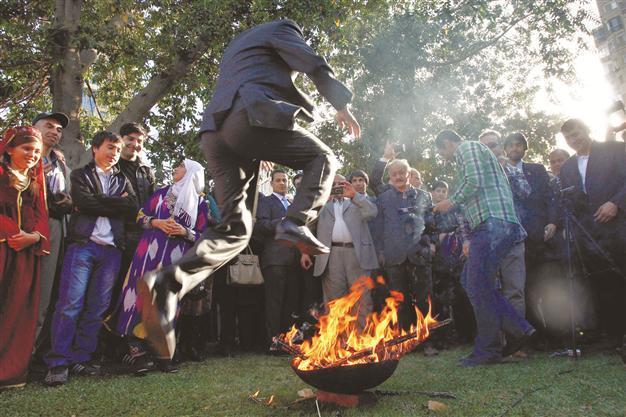Spring fever is in the air
Aylin Öney TAN - aylin.tan@hdn.com.tr
 Spring is in the air! Last week it was Nevruz, tonight Pesah starts and soon it will be Easter. The roots of spring festivals in Turkey are numerous, some having roots in Central Asian shamanic rituals and some dating back to the Hittite period or even before to Sumerian times in Mesopotamia.
Spring is in the air! Last week it was Nevruz, tonight Pesah starts and soon it will be Easter. The roots of spring festivals in Turkey are numerous, some having roots in Central Asian shamanic rituals and some dating back to the Hittite period or even before to Sumerian times in Mesopotamia. Anatolia is often called the cradle of civilizations as it has been home to numerous religions and communities over the course of its long history. Each community has its own way of celebrating the change of seasons with spring festivals like Tu Bishvat, Pesah, Nevruz, Easter, Hıdrellez and Aya Yorgi (St. George) Day. The coming of spring is a particularly festive occasion, especially that of Nevruz, as it involves open-air celebrations. Whatever the origin or roots and regardless of religion, all spring festivals praise the renewal of nature and bear hope for the future.
Nevruz is celebrated on March 21, on the day of the spring equinox. The word is of Persian origin, literally meaning “New Day,” and has numerous spellings in many languages and dialects. Iranian Nooruz is the most important, being also celebrated as the new year. The preparation for the day starts days ahead, first by sprouting wheat berries. The freshly sprouted wheatgrass is placed on tables in shallow trays with boiled, dyed eggs surrounded by dried fruits and nuts.
Sprouting wheat has another purpose. A potent sweet paste, sümenek, is prepared by pounding freshly sprouted wheat and cooking it into a thick paste. Also called by names like samanak, samani, uğut and uhut, the dense, honey-like paste symbolizes the sweetness of new life at Nevruz. This is a tradition observed by Turkic countries and communities with Turkic roots living in Turkey, like Azeris, Turcomans etc., and also by the followers of the Baha’i faith, who have strong Iranian cultural connections. Needless to say, sprouting wheat for Nevruz and preparing samanak is a strong tradition in Iran. The Ottoman court tradition of having a very potent spicy sweet paste, Nevruziye, for the day of Nevruz, probably has roots in the Central Asian tradition of the wheat sprout paste. The tradition survives in the Aegean city of Manisa, where it is now called Mesir Macunu, often marketed under the nickname Turkish Viagra for obvious reasons.
Apart from wheatgrass, the most symbolic food for Nevruz must be the egg. Eggs seem to be the common symbol in all spring festivals, be it Easter or Pesah. At Nevruz, when peeling hard-boiled eggs, you also peel away the troubles of the previous year. Eggs symbolize birth and rebirth, the complete lifecycle. Egg tapping is the most popular game for kids at Nevruz picnics. Eggs, sometimes dyed bright red just like at Easter, contrast beautifully with the fresh greens of the tables, another must for a spring festival.
We hope all the eggs tapped by Kurdish and Turkish kids in southeastern Turkey last week for Nevruz will peel away the troubles of the past and sprout seeds of hope for a shared future just like the shared spring rituals of this land.
Recipe of the Week: Eggs are the symbol of all spring festivals. This egg salad from Diyarbakır will bring spring to your table in all senses like a delightful bouquet of narcissus. Nergizleme egg salad, named after the pretty narcissus, meaning narcissus-like, bears the same vibrant color combination, bright yellow, green and white. Put a dozen eggs in a pan, pour cold water to cover and put it on a flame. When it reaches a boil wait 4 to 6 minutes, depending on the size of the eggs and how you like them and pour cold water over them to stop the cooking. This way the eggs will retain a slightly soft yolk. When cool, peel the eggs and cut lengthwise into quarters. Chop finely a small bunch of parsley and the green parts of 12 spring onions. Mix the juice of a lemon with half a glass of extra virgin olive oil and half a teaspoon of salt. Toss half of the salad dressing with the greens and arrange on a platter. Place the quartered eggs over the greens and pour the rest of the dressing on the eggs. Sprinkle bright red chili pepper flakes to complete the colors of the narcissus. Serve with lots of flat bread to roll into a dürüm.
Bite of the week
Fork of the Week: Early spring is just the right time for foraging. Wild edible greens are my favorite, and the place for one of the best in Istanbul is at Sıdıka in Beşiktaş. http://www.sidika.com.tr/indexeng.htm. Try her tasty Aegean herb platter for a real feel of spring.
Cork of the Week: It can be wise to stop the booze for nice spring detox. My choice is definitely the Nevruz sherbet of Çiya in Kadıköy. The cool, refreshing, bright green sherbet is only very slightly sweetened and is a delightful fresh combination of seven herbs and wild greens including watercress, goosefoot, sorrel, mint, wild green apples and pears and the untranslatable “nevruz otu ” the essential herb of Nevruz sherbet.











